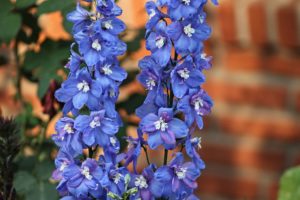Be Pro-Active: Stake Your Plants
Single stem plants such as delphiniums do well with support from a single stake a few inches shorter than the expected height of the plant.
By Thomas Christopher
I am a bit of a procrastinator, which explains why I will never be a master at staking and supporting perennials in the garden. For when it comes to staking, promptness is everything. The idea behind really good staking is to provide the support the plant needs as inconspicuously as possible. That means starting early, practically as a plant emerges from the soil.
Why do you have to be so pro-active? Consider my own habits. I tend to wait until a plant is starting to flop before I insert stakes and start cinching the plant in with twine. A stem that has flopped will maintain its curved shape even when tied up, and will always have a constricted, Joan of Arc look, as if it were brutally lashed to the stake. Whereas if I installed the stake early and began tying in the plant as it was growing, directing its growth, the plant would grow up straight and lean on its support as casually and naturally as you’d prop yourself on an elbow at the table.
Promptness is particularly important, of course, if you are using a “grow through” support such as a peony ring (essentially a circular grid raised up on legs). You should lay this over the plant shoots as they emerge, pushing the legs of the support all the way into the soil. Then, as the shoots grow up, you pull up on the grid so that it stays within 6 inches of their tips. In this way, the support remains hidden by the plant’s foliage but still keeps its stems upright and straight.
One place where I learned much about staking is Wave Hill, the great public garden in the Fieldston neighborhood in the Bronx. The gardeners there have elevated staking to the level of an art form. They grow most of their own stakes, salvaging them from the twigs and shoots that they prune off of trees and shrubs, although they do supplement these with store-bought bamboo stakes. For ties, they use various weights of twines made from natural fibers such as jute or hemp. Sticking to organic materials means that at the end of the season they can dispose of the whole tangled mess in the compost heap.
Plants with a single stem such as delphiniums these craftsmen may support with a single stake a few inches shorter than the expected height of the plant. They inserted that into the ground beside an emerging shoot. Lightweight twine is used to loosely tie the shoot to the stake as the shoot grows upward. At least two and more often three ties are used, because a single tie just serves as a fulcrum over which the staked shoot will bend and snap.
Plants with lots of thin stems such as asters (Aster or Symphiotrichum) or Culver’s root (Veronicastrum virginicum) the Wave Hill gardeners will enclose with a ring of branching twigs, overlapping the arms of the twigs slightly. Alternatively, they may use colorful shoots from willows or shrubby dogwoods, pushing the ends into the ground to create a circular fence of overlapping hoops. In either case, the supports actually add to the attractiveness of the floral display.
For larger multi-stemmed plants, such as hydrangeas, the gardeners set six to eight bamboo stakes around the perimeter of the plant. Then they tie a length of light hemp twine to one stake, pass the string through the stems to the opposite stake, tie it off, and pass the string back to a third stake, eventually creating a star-shaped pattern of string. Finally, they run the string in a circle around the outside of the stakes. The result is a system of support which is secure, which keeps the stems from slumping together, and yet is inconspicuous.
Perhaps if I approach my staking more artistically, like the gardeners at Wave Hill, I’ll succeed in making it more timely this year. This will definitely pay off by midsummer.
Thomas Christopher is the co-author of “Garden Revolution” (Timber Press, 2016) and is a volunteer at Berkshire Botanical Garden. berkshirebotanical.org
Be-a-Better-Gardener is a community service of Berkshire Botanical Garden, one of the nation’s oldest botanical gardens in Stockbridge, MA. Its mission to provide knowledge of gardening and the environment through 25 display gardens and a diverse range of classes informs and inspires thousands of students and visitors on horticultural topics every year. Thomas Christopher is the co-author of Garden Revolution (Timber press, 2016) and is a volunteer at Berkshire Botanical Garden. berkshirebotanical.org.




